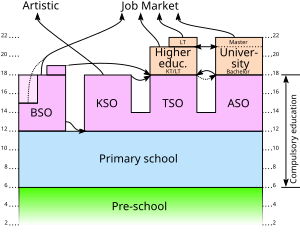
Back التعليم في بلجيكا Arabic Belçikada təhsil Azerbaijani Bildungssystem in Belgien German تحصیل در بلژیک Persian Système éducatif en Belgique French Belgium oktatási rendszere Hungarian Istruzione in Belgio Italian ബെൽജിയത്തിലെ വിദ്യാഭ്യാസം Malayalam Oświata w Belgii Polish Educação na Bélgica Portuguese

Education in Belgium is regulated and for the most part financed by one of the three communities: Flemish, French and German-speaking. Each community has its own school system, with small differences among them. The federal government plays a very small role: it decides directly the age for mandatory schooling and indirectly the financing of the communities.
The schools can be divided in three groups (Dutch: netten; French: réseaux):
- Schools owned by the communities (GO! Onderwijs van de Vlaamse gemeenschap; Wallonie-Bruxelles Enseignement)
- Subsidized public schools (officieel gesubsidieerd onderwijs; réseau officiel subventionné), organized by provinces, municipalities or the Brussels French Community Commission
- Subsidized free schools (vrij gesubsidieerd onderwijs; réseau libre subventionné), mainly organized by an organization affiliated to the Catholic church
The latter is the largest group, both in number of schools and in number of pupils.
Education in Belgium is compulsory between the ages of 5 and 18 or until one graduates from secondary school.[1]
- ^ (Dutch) Leerplicht